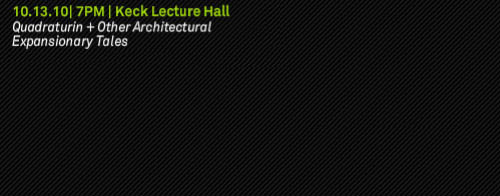 [Image: Drawing courtesy Geothermal Futures Lab].
[Image: Drawing courtesy Geothermal Futures Lab].
In the general chaos of renovating a house here in Los Angeles, I missed this lecture and reception on Friday night, launching a semi-fictional “Geothermal Futures Lab” at SCI-Arc.
It involves installing a gold-plated laser somewhere deep in the San Andreas Fault to extract geothermal energy from the landscape. Think of it as a kind of gonzo version of the San Andreas Fault Observatory at Depth.
 [Image: Drawing courtesy Geothermal Futures Lab].
[Image: Drawing courtesy Geothermal Futures Lab].
The press release, from architect Mark Foster Gage, is a great example of a solipsistic inventor’s imagination at full blast—featuring “geothermal resonance technologies,” nano-gold foil-wrapped laser components, an “experimental phenolic cured resin foam,” and so on.
The functioning of the equipment would also rely, at least partially, on existing “metal deposits along the strike-slipping continental plates,” bringing to mind both the naturally occurring nuclear reactors in Gabon and the giant Earth-battery cells circulating beneath the forests of central Canada: landscapes whose geochemistry lends them to these sorts of giant, speculative energy installations.
Or see Norway’s extraordinary Hessdalen lights, a geologically electrified valley that seems ripe for a Mark Foster Gage-like architectural-energy proposal.
In all these cases, of course, what’s also worth noting is that, as fantastic as this sort of facility might seem—whether it’s a lab extracting electrical energy from the San Andreas Fault, as Foster Gage suggests, or one positioned above geochemical differentials in the Canadian soil—as soon as the power it supplies can be made available through the national grid, it would immediately pass from some sort of absolutely bonkers sci-fi vision of the near-future to, frankly, something utterly mundane. It would simply be where the power comes from, and people would shrug it off as a mere utility (if they think about it at all).
But what this also means is that we might already, right now, be missing out on seeing the truly otherworldly nature of our own power-generation facilities, which have all too easily disappeared into the infrastructural background of the modern world. Science fiction is already here, in other words, we just tend to refer to it as infrastructure. See, for example, Crescent Dunes or PS10. Or, for that matter, take a harder look at oil.

 [Images: Drawings courtesy Geothermal Futures Lab].
[Images: Drawings courtesy Geothermal Futures Lab].
In any case, here’s a sample from the project text, obligatory typos and all:
The exhibited technology capitalizes on the unique tungsten-saturated substrate of the San Andres fault through the use of a visible-light Q-switched Nd:YAG lasers, tuned to extract sustainable magno-electrical energy from a +678 degree Kelvin supercritical water deposits located adjacent to a stable magma chamber 4.4km beneath the Earths surface. This supercritical water, that behaves both as liquid and gas, is vaporized through 3,780 Kelvin bursts which at peak power induce a supercritical matter state releasing energy in exponential excess of its matter equivalent. The presence of heterogeneous frequency fields in metal deposits along the strike-slipping continental plates supercharges the pockets of supercritical water with magnetic nuons which are forced upwards with velocity µ as a result of the pressure gradient along the vertical faults. Due to the variable decay rate of metals in the presence of such high trajectory nuons, the prototype laser resonance mechanism itself is encased in an experimental phenolic cured resin foam (Cas no. 000050-00-0 with a normal specific gravity of 120 kg/m3) which insulates the process from outside magnetic interference. For rapid nuon decay protection the foam resin is additionally coated with the same seven µm micrometer nano-gold foil used to encase existing NASA satellites. This thick film of gold nano-molecules particles gives the machine its striking gold aesthetic appearance.
A nuon-resistant radiant machine buried in the San Andreas Fault, extracting energy from the friction between tectonic plates? With lasers? Yes, please.

 [Images: Drawings courtesy Geothermal Futures Lab].
[Images: Drawings courtesy Geothermal Futures Lab].
The exhibition itself is up until March 4; stop by SCI-Arc to see more or check out the project’s website.
(Earlier on BLDGBLOG: San Andreas: Architecture for the Fault. Thanks to Wayne Chambliss and Eva Barbarossa for the heads up!)
 [Image: The turkey vulture’s “verification flight pattern,” taken from “The Role of Olfaction in Food Location by the Turkey Vulture” by Kenneth E. Stager (
[Image: The turkey vulture’s “verification flight pattern,” taken from “The Role of Olfaction in Food Location by the Turkey Vulture” by Kenneth E. Stager ( While I’m announcing things, I also want to give a heads up to anyone in the Los Angeles area that I’ll be lecturing on Wednesday evening, October 13th, over at
While I’m announcing things, I also want to give a heads up to anyone in the Los Angeles area that I’ll be lecturing on Wednesday evening, October 13th, over at